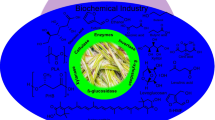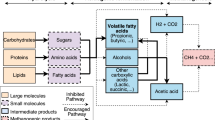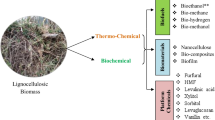Abstract
Cellulosic ethanol production from non-detoxified furfural residues produced at different operating conditions from sugarcane bagasse was investigated. Simultaneous saccharification and fermentation (SSF) technique and preconditioned industrial strains of Saccharomyces cerevisiae, i.e., EthanolRed® and CelluX™4, were used for fermentation. The highest furfural yield of 69% (11.44 g/100 g of dry bagasse) was achieved at 170 °C and 0.5 wt.% H2SO4 (170–200 °C and 0–1 wt.% H2SO4), with corresponding ethanol yields of 77–95% (9.57–11.58 g/100 g of dry bagasse). The mass of ethanol produced reflected conversion of about 50% of cellulose in raw biomass due to cellulose degradation during furfural production. No production conditions could be found where both furfural and ethanol yields were maximized, indicating an unavoidable compromise between the two co-products. Furfural production conditions that provided an acceptable compromise between furfural and ethanol during co-production from sugarcane bagasse were 170 °C and 0.25 wt.% H2SO4, resulting in furfural mass of 7.64 g/100 g of dry bagasse and ethanol mass of 9.86 and 10.91 g/100 g of dry bagasse when using EthanolRed® and CelluX™4, respectively.



Similar content being viewed by others
References
Panahi HSK, Dehhaghi M, Kinder JE, Ezeji TC (2019) A review on green liquid fuels for the transportation sector: a prospect of microbial solutions to climate change. Biofuel Res J 23:995–1024. https://doi.org/10.18331/BRJ2019.6.3.2
Tabatabaei M, Mortaza A, Valijanian E et al (2020) A comprehensive review on recent biological innovations to improve biogas production, part 1: upstream strategies. Renew Energy 146:1204–1220. https://doi.org/10.1016/j.renene.2019.07.037
Machineni L (2020) Lignocellulosic biofuel production: review of alternatives. Biomass Convers Biorefinery 10:779–791. https://doi.org/10.1007/s13399-019-00445-x
Ho MC, Ong VZ, Wu TY (2019) Potential use of alkaline hydrogen peroxide in lignocellulosic biomass pretreatment and valorization – a review. Renew Sust Energ Rev 112:75–86. https://doi.org/10.1016/j.rser.2019.04.082
Biddy MJ, Scarlata C, Christopher K (2016) Chemicals from biomass: a market assessment of bioproducts with near-term potential
Bohre A, Dutta S, Saha B, Abu-omar MM (2015) Upgrading furfurals to drop-in biofuels: an overview. ACS Sustain Chem Eng 3:1263–1277. https://doi.org/10.1021/acssuschemeng.5b00271
Dalvand K, Rubin J, Gunukula S, Clayton Wheeler M, Hunt G (2018) Economics of biofuels: market potential of furfural and its derivatives. Biomass Bioenergy 115:56–63. https://doi.org/10.1016/j.biombioe.2018.04.005
Chen H, Qin L, Yu B (2015) Furfural production from steam explosion liquor of rice straw by solid acid catalysts (HZSM-5). Biomass Bioenergy 73:77–83. https://doi.org/10.1016/j.biombioe.2014.12.013
Cai CM, Zhang T, Kumar R, Wyman CE (2014) Integrated furfural production as a renewable fuel and chemical platform from lignocellulosic biomass. J Chem Technol Biotechnol 89:2–10. https://doi.org/10.1002/jctb.4168
Lavarack BP, Griffin GJ, Rodman D (2002) The acid hydrolysis of sugarcane bagasse hemicellulose to produce xylose, arabinose, glucose and other products. Biomass Bioenergy 23:367–380
Mesa L, Morales M, González E, Cara C, Romero I, Castro E, Mussatto SI (2014) Restructuring the processes for furfural and xylose production from sugarcane bagasse in a biorefinery concept for ethanol production. Chem Eng Process Process Intensif 85:196–202. https://doi.org/10.1016/j.cep.2014.07.012
Lee CBTL, Wu TY (2020) A review on solvent systems for furfural production from lignocellulosic biomass. Renew Sust Energ Rev 137:110172. https://doi.org/10.1016/j.rser.2020.110172
Rosales-Calderon O, Arantes V (2019) A review on commercial-scale high-value products that can be produced alongside cellulosic ethanol. Biotechnol Biofuels 12:1–58. https://doi.org/10.1186/s13068-019-1529-1
Farzad S, Mandegari MA, Guo M, Haigh KF, Shah N, Görgens JF (2017) Multi-product biorefineries from lignocelluloses: a pathway to revitalisation of the sugar industry? Biotechnol Biofuels 10:1–24. https://doi.org/10.1186/s13068-017-0761-9
Zeitsch KJJ (2000) The chemistry and technology of furfural and its many by-products
Dashtban M, Technologies A, Dashtban M (2012) Production of furfural: overview and challenges. J Sci Technol For Prod Process 2:44–53
Danon B, Marcotullio G, De Jong W (2013) Mechanistic and kinetic aspects of pentose dehydration towards furfural in aqueous media employing homogeneous catalysis. Green Chem:1–16. https://doi.org/10.1039/b000000x
Cardona CA, Quintero JA, Paz IC (2010) Production of bioethanol from sugarcane bagasse: status and perspectives. Bioresour Technol 101:4754–4766. https://doi.org/10.1016/j.biortech.2009.10.097
Steinbach D, Kruse A, Sauer J (2017) Pretreatment technologies of lignocellulosic biomass in water in view of furfural and 5-hydroxymethylfurfural production- a review. Biomass Convers Biorefinery 7:247–274. https://doi.org/10.1007/s13399-017-0243-0
Silva JFL, Selicani MA, Junqueira TL et al (2017) Integrated furfural and first generation bioethanol production: process simulation and techno-economic analysis. Brazilian J Chem Eng 34:623–634. https://doi.org/10.1590/0104-6632.20170343s20150643
Avci A, Saha BC, Kennedy GJ, Cotta MA (2013) High temperature dilute phosphoric acid pretreatment of corn stover for furfural and ethanol production. Ind Crop Prod 50:478–484. https://doi.org/10.1016/j.indcrop.2013.07.055
Yoo CG, Kuo M, Kim TH (2012) Ethanol and furfural production from corn stover using a hybrid fractionation process with zinc chloride and simultaneous saccharification and fermentation (SSF). Process Biochem 47:319–326. https://doi.org/10.1016/j.procbio.2011.11.018
Shi X, Zhao B, Zhou H, Tian Y, Qiao Y, Ji B (2019) Direct saccharification and fermentation for high glucose and ethanol production from non-detoxified furfural residue without any pretreatment. Energy Technol Environ Sci 4:7844–7850. https://doi.org/10.1002/slct.201901367
Wang K, Yang H, Chen Q, Sun R cang (2013) Influence of delignification efficiency with alkaline peroxide on the digestibility of furfural residues for bioethanol production. Bioresour Technol 146:208–214. https://doi.org/10.1016/j.biortech.2013.07.008
Xing Y, Bu L, Sun D, Liu Z, Liu S, Jiang J (2016) Enhancement of high-solids enzymatic hydrolysis and fermentation of furfural residues by addition of Gleditsia saponin. FUEL 177:142–147. https://doi.org/10.1016/j.fuel.2016.03.024
Bu L, Tang Y, Xing Y, Zhang W, Shang X, Jiang J (2014) Comparison of hydrophilic variation and bioethanol production of furfural residues after delignification pretreatment. Biosci Biotechnol Biochem 78:1435–1443. https://doi.org/10.1080/09168451.2014.921556
Ji L, Zheng T, Zhao P, Zhang W, Jiang J (2016) Ethanol production from a biomass mixture of furfural residues with green liquor-peroxide saccarified cassava liquid. BMC Biotechnol 16:1–11. https://doi.org/10.1186/s12896-016-0278-5
Mokomele T, Sousa C, Balan V et al (2018) Ethanol production potential from AFEX™ and steam-exploded sugarcane residues for sugarcane biorefineries. Biotechnol Biofuels 11:1–21. https://doi.org/10.1186/s13068-018-1130-z
Watanabe K, Tachibana S, Konishi M (2019) Modeling growth and fermentation inhibition during bioethanol production using component profiles obtained by performing comprehensive targeted and non-targeted analyses. Bioresour Technol 281:260–268. https://doi.org/10.1016/j.biortech.2019.02.081
Wang X, Fai Y, Li Y et al (2017) Inhibitory effects of phenolic compounds of rice straw formed by saccharification during ethanol fermentation by Pichia stipitis. Bioresour Technol 244:1059–1067. https://doi.org/10.1016/j.biortech.2017.08.096
Xu K, Seo Y, Li J, Li C (2019) Resistance mechanisms and reprogramming of microorganisms for efficient biorefinery under multiple environmental stresses. Synth Syst Biotechnol J 4:92–98. https://doi.org/10.1016/j.synbio.2019.02.003
He J, Zhang W, Liu X, Xu N, Xiong P (2016) Optimization of prehydrolysis time and substrate feeding to improve ethanol production by simultaneous saccharification and fermentation of furfural process residue. J Biosci Bioeng 122:563–569. https://doi.org/10.1016/j.jbiosc.2016.04.012
Pabari RM, Ramtoola Z (2012) Application of face centred central composite design to optimise compression force and tablet diameter for the formulation of mechanically strong and fast disintegrating orodispersible tablets. Int J Pharm 430:18–25. https://doi.org/10.1016/j.ijpharm.2012.03.021
Yemiş O, Mazza G (2011) Acid-catalyzed conversion of xylose, xylan and straw into furfural by microwave-assisted reaction. Bioresour Technol 102:7371–7378. https://doi.org/10.1016/j.biortech.2011.04.050
Bamufleh HS, Alhamed YA, Daous MA (2013) Furfural from midribs of date-palm trees by sulfuric acid hydrolysis. Ind Crop Prod 42:421–428. https://doi.org/10.1016/j.indcrop.2012.06.008
Mesa L, Martínez Y, Barrio E, González E (2017) Desirability function for optimization of dilute acid pretreatment of sugarcane straw for ethanol production and preliminary economic analysis based in three fermentation configurations. Appl Energy 198:299–311. https://doi.org/10.1016/j.apenergy.2017.03.018
Mao L, Zhang L, Gao N, Li A (2012) FeCl3 and acetic acid co-catalyzed hydrolysis of corncob for improving furfural production and lignin removal from residue. Bioresour Technol 123:324–331. https://doi.org/10.1016/j.biortech.2012.07.058
Zhao M, Shi D, Lu X, Zong H, Zhuge B, Ji H (2019) Ethanol fermentation from non-detoxified lignocellulose hydrolysate by a multi-stress tolerant yeast Candida glycerinogenes mutant. Bioresour Technol 273:634–640. https://doi.org/10.1016/j.biortech.2018.11.053
Guo Z, Olsson L (2016) Physiological responses to acid stress by Saccharomyces cerevisiae when applying high initial cell density. FEMS Yeast Res 16:1–11. https://doi.org/10.1093/femsyr/fow072
Unrean P, Khajeeram S, Laoteng K (2016) Systematic optimization of fed-batch simultaneous saccharification and fermentation at high-solid loading based on enzymatic hydrolysis and dynamic metabolic modeling of Saccharomyces cerevisiae. Appl Microbiol Biotechnol 100:2459–2470. https://doi.org/10.1007/s00253-015-7173-1
Boshoff S, Gottumukkala LD, Van Rensburg E, Görgens J (2016) Paper sludge (PS) to bioethanol: evaluation of virgin and recycle mill sludge for low enzyme, high-solids fermentation. Bioresour Technol 203:103–111. https://doi.org/10.1016/j.biortech.2015.12.028
Favaro L, Viktor MJ, Rose SH, Viljoen-Bloom M, van Zyl WH, Basaglia M, Cagnin L, Casella S (2015) Consolidated bioprocessing of starchy substrates into ethanol by industrial Saccharomyces cerevisiae strains secreting fungal amylases. Biotechnol Bioeng 112:1751–1760. https://doi.org/10.1002/bit.25591
Sluiter A, Hames B, Ruiz R, et al (2012) Determination of structural carbohydrates and lignin in biomass
Raman JK, Gnansounou E (2015) Furfural production from empty fruit bunch - a biorefinery approach. Ind Crop Prod 69:371–377. https://doi.org/10.1016/j.indcrop.2015.02.063
Sánchez C, Serrano L, Andres MA, Labidi J (2013) Furfural production from corn cobs autohydrolysis liquor by microwave technology. Ind Crop Prod 42:513–519. https://doi.org/10.1016/j.indcrop.2012.06.042
Vázquez M, Oliva M, Téllez-Luis SJ, Ramírez JA (2007) Hydrolysis of sorghum straw using phosphoric acid: evaluation of furfural production. Bioresour Technol 98:3053–3060. https://doi.org/10.1016/j.biortech.2006.10.017
Vallejos ME, Felissia FE, Kruyeniski J, Area MC (2015) Kinetic study of the extraction of hemicellulosic carbohydrates from sugarcane bagasse by hot water treatment. Ind Crop Prod 67:1–6. https://doi.org/10.1016/j.indcrop.2014.12.058
García-Domínguez MT, García-Domínguez JC, Feria MJ, Gómez-Lozano DM, López F, Díaz MJ (2013) Furfural production from Eucalyptus globulus: optimizing by using neural fuzzy models. Chem Eng J 221:185–192. https://doi.org/10.1016/j.cej.2013.01.099
Aguilar R, Ramírez JA, Garrote G, Vázquez M (2002) Kinetic study of the acid hydrolysis of sugar cane bagasse. J Food Eng 55:309–318. https://doi.org/10.1016/S0260-8774(02)00106-1
Li H, Wang X, Liu C, Ren J, Zhao X, Sun R, Wu A (2016) An efficient pretreatment for the selectively hydrothermal conversion of corncob into furfural: the combined mixed ball milling and ultrasonic pretreatments. Ind Crop Prod 94:721–728. https://doi.org/10.1016/j.indcrop.2016.09.052
Dussan K, Girisuta B, Haverty D, Leahy JJ, Hayes MHB (2013) Kinetics of levulinic acid and furfural production from Miscanthus × giganteus. Bioresour Technol 149:216–224. https://doi.org/10.1016/j.biortech.2013.09.006
Albers E, Larsson C, Liden G et al (1996) Influence of the nitrogen source on Saccharomyces cerevisiae anaerobic growth and product formation. Appl Environ Microbiol 62:3187–3195
Wang Z, Zhuge J, Fang H, Prior BA (2001) Glycerol production by microbial fermentation: a review. Biotechnol Adv 19(19):201–223
Hanly TJ, Henson MA (2014) Dynamic model-based analysis of furfural and HMF detoxification by pure and mixed batch cultures of S. cerevisiae and S. stipitis. Biotechnol Bioeng 111:272–284. https://doi.org/10.1002/bit.25101
Hu F, Jung S, Ragauskas A (2012) Pseudo-lignin formation and its impact on enzymatic hydrolysis. Bioresour Technol 117:7–12. https://doi.org/10.1016/j.biortech.2012.04.037
Shinde SD, Meng X, Kumar R, Ragauskas AJ (2018) Recent advances in understanding the pseudo-lignin formation in a lignocellulosic biorefinery. Green Chem 20:2192–2205. https://doi.org/10.1039/c8gc00353j
Acknowledgements
We thank the National Research Foundation (South Africa) and Sugar Milling Research Institute for the support. The Sugarcane Technology Enabling Programme for Bioenergy (STEP-Bio), a public-private partnership between the South African sugarcane processing industry and the Department of Science and Technology (DST) Sector Innovation Fund (SIF), is acknowledged for the partial support. We extend our gratitude to Novozymes for providing us with enzymes, Lesaffre (Leaf Technologies, France) for providing us with yeast strains, Sezela Illovo for providing us with furfural residues and technical advice, and RCL for providing us with furfural residues. Finally yet importantly, we also thank the Analytical Lab team of the Department of Process Engineering, Stellenbosch University.
Author information
Authors and Affiliations
Corresponding author
Ethics declarations
Conflict of interest
The authors declare no competing interests.
Additional information
Publisher’s note
Springer Nature remains neutral with regard to jurisdictional claims in published maps and institutional affiliations.
Rights and permissions
About this article
Cite this article
Ntimbani, R.N., Farzad, S. & Görgens, J.F. Furfural production from sugarcane bagasse along with co-production of ethanol from furfural residues. Biomass Conv. Bioref. 12, 5257–5267 (2022). https://doi.org/10.1007/s13399-021-01313-3
Received:
Revised:
Accepted:
Published:
Issue Date:
DOI: https://doi.org/10.1007/s13399-021-01313-3




